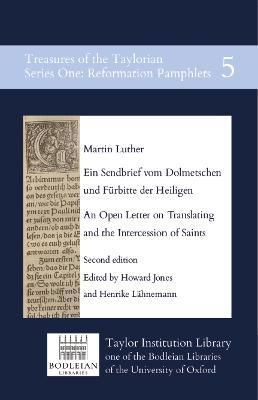Ein Sendbrief vom Dolmetschen und Fürbitte der Heiligen / An Open Letter on Translating and the Intercession of Saints

Ein Sendbrief vom Dolmetschen und Fürbitte der Heiligen / An Open Letter on Translating and the Intercession of Saints
The edition is part of the Reformation Pamphlet series of the Taylor Institution Library in Oxford which aims to make the treasures of the library accessible via open access editions on https: //editions.mml.ox.ac.uk/ and to bring together interdisciplinary expertise on different aspects of these historic holdings. Reformation historian Ulrich Bubenheimer identifies for the first time the addressee of the Sendbrief, linguist Howard Jones offers insights into the translation process, and Germanist Henrike Lähnemann adds the book-historical perspective.
In the Open Letter on Translation Luther offers general advice on translation as well as a defence of some of the specific translation choices he made in his German New Testament. From these it becomes clear what his guiding principles were as a translator: an intimate knowledge of the source and target language, a feel for the idiom of both, and an understanding of the author's purpose. The same questions preoccupy translators today, whether they are working with sacred texts or not. The Open Letter affords us a glimpse into the translation technique of one its most successful exponents.
The Open Letter also gives us a taste of Luther's style and method of argument. His syntax and vocabulary are plain and direct, his tone sometimes academic but more often informal, and the text is
57.78Lei
57.78Lei
Livrare in 2-4 saptamani
Descrierea produsului
The edition is part of the Reformation Pamphlet series of the Taylor Institution Library in Oxford which aims to make the treasures of the library accessible via open access editions on https: //editions.mml.ox.ac.uk/ and to bring together interdisciplinary expertise on different aspects of these historic holdings. Reformation historian Ulrich Bubenheimer identifies for the first time the addressee of the Sendbrief, linguist Howard Jones offers insights into the translation process, and Germanist Henrike Lähnemann adds the book-historical perspective.
In the Open Letter on Translation Luther offers general advice on translation as well as a defence of some of the specific translation choices he made in his German New Testament. From these it becomes clear what his guiding principles were as a translator: an intimate knowledge of the source and target language, a feel for the idiom of both, and an understanding of the author's purpose. The same questions preoccupy translators today, whether they are working with sacred texts or not. The Open Letter affords us a glimpse into the translation technique of one its most successful exponents.
The Open Letter also gives us a taste of Luther's style and method of argument. His syntax and vocabulary are plain and direct, his tone sometimes academic but more often informal, and the text is
Detaliile produsului











